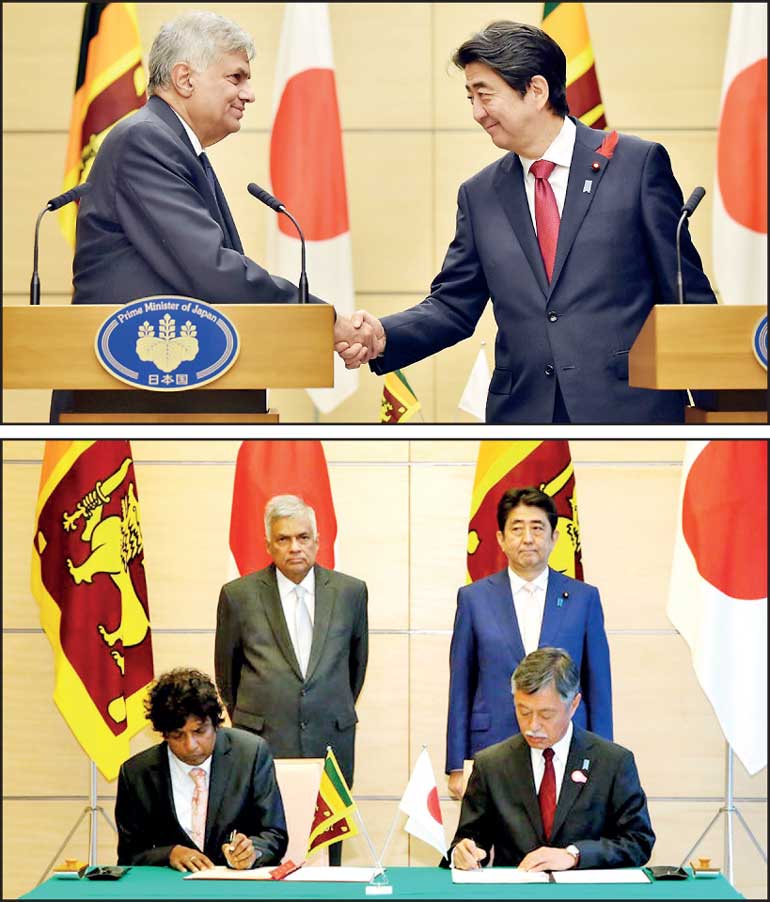Sunday Dec 14, 2025
Sunday Dec 14, 2025
Saturday, 24 September 2022 00:18 - - {{hitsCtrl.values.hits}}

By Sisil Panditha
President Ranil Wickremesinghe will be representing Sri Lanka for the state funeral of the late Japanese Prime Minister Shinzo Abe, which is to be held on 27 September in Tokyo.
Former Japanese Prime Minister Shinzo Abe was a great friend of Sri Lanka and a great strategist, not only for national security of Japan, but for the entire Indo-Pacific region. He was Prime Minister of Japan five times and was assassinated on 5 July this year in the city of Nara, which is famous for its Todai era Buddhist temples. His grandfather, Nobuske Ishi was also the Prime Minister of Japan between 1957 and 1960. Today, he is survived by his spouse Akie.
The Sri Lankan national flag was at half-mast on 12 July, when a national day of mourning was announced out of respect to the former Japanese Prime Minister. At the time, Prime Minister Ranil Wickremesinghe signed the condolence book at the Embassy of Japan in Colombo, where he wrote: “We have lost a Prime Minister who gave leadership to Asia”.
Shinzo Abe described his vision in 2007 at India’s Parliament as the “confluence of two seas”, promoting an Indo-Pacific security dialogue for which brings freedom and prosperity in democracy across Asia.
Diplomatic relations between Sri Lanka and Japan were established in 1952 with the former Prime Minister of Japan Shigeru Yoshida and J.R. Jayewardene. Sri Lanka’s relationship with Japan started with a letter sent in 1889 by Hikkaduwe Sri Sumangala Thero with Anagarika Dharmapala and Colonel Steel Olcott, addressed to The Chief High Priest of Japan. In Kyoto, they witnessed the celebrations and promulgation of the new Japanese constitution (Dai Nihon Tekoku Kempo) during the Meiji era on 11 February 1889. Later, in 1951 on the way to the famous Treaty of San Francisco peace conference, the then Finance Minister J.R. Jayewardene visited Tokyo as a representative of Ceylon. He visited Kamakura on 31 August 1951 and had a meeting with the Buddhist scholars of Japan at the Matsugaoka Library upon a hill opposite the Engakuji temple. Details of the meeting were not disclosed, but before his departure to San Francisco, he wrote to Prof. G.P. Malalasekara about a mega conference.
The first Japanese Prime Minister that visited Sri Lanka was Nobusuke Kishi, the grandfather of Shinzo Abe, in 1957. 33 years later, former Japanese Prime Minister Toshiki Kaifu visited in 1990. Former Prime Minister Shinzo Abe then visited Colombo on 7 September 2014 with his wife and a delegation over 50 businessmen. He described Sri Lanka as a country with a growing influence in economic and political domains and was in Colombo to boost economic and security ties and to strengthen maritime territorial cooperation. At the time, Japan was ready to provide patrol boats to help Sri Lanka bolster its maritime security. The leaders of both countries shared the view on building a new partnership in maritime security, which also reflects Japan’s interest in keeping open shipping lanes that supply petroleum from Middle East for their national energy requirements.
Japan, the largest single foreign aid donor to Sri Lanka, also remained neutral at the UNHRC session in March 2014 that voted to set up the war crimes probe. Shinzo Abe, on his visit, also addressed the Japan-Sri Lanka Business Forum in addition to bilateral engagements. He also visited the Kelaniya temple to offer flowers where we believe the Gautama Buddha visited, to receive his blessings from the Triple Gem. Ranil Wickremesinghe, who was the Opposition Leader at the time, was not invited by either local or Japanese authorities for any occasion which was an unusual change in protocol.
At Parliament on 3 August, President Ranil Wickremesinghe mentioned, “Regrettably, the traditional friendship between Japan and Sri Lanka has been adversely affected. The Hon. Late Shinzo Abe, the former Prime Minister of Japan, who was a close friend of Sri Lanka, took the initiative to offer us these projects. He sadly was killed recently. At this moment, I wish to transfer merit to Hon. Abe, according to our religious beliefs.”
Ranil Wickremesinghe visited Japan many times, starting in 1998 as the leader of the opposition and understands the country and its culture. As the Prime Minister, he built a good relationship in 2015 with Prime Minister Shinzo Abe after a seven-year gap of not visiting Japan and even participated in the Science and Technology for Society forum in Kyoto. On the next visit to Japan in 2017, the two countries exchanged notes for three development projects amounting to JP¥ 45.7 billion for the Kalu Ganga Water Supply Expansion project, Rural Infrastructure Development Project in Emerging Regions, and Trincomalee Port Development Program. In 2015, former Prime Minister Abe also suggested that the Sri Lanka Navy join the Malabar exercise as an observer, which was done so in 2018.
While Japan strengthens maritime security through technical projects and equipment provision, they also provided patrol boats to the Sri Lanka Coast Guard, in line with the Grant Agreement signed by GoSL and JICA on 30 June 2016. Japan could have also exported used P-3C patrol aircrafts to Colombo. In April 2017, Japan announced the decision to invest in port infrastructure with JP¥ 1 billion that was dedicated to improving the Trincomalee port, which had been a topic of discussion since 2010.
Now torn between China and India, Sri Lanka has to manage a delicate balancing act. However, Japan and Sri Lanka continue to enjoy friendly relations as a result of the hard work of many individuals, including the late former PM Shinzo Abe and Chairman of Japan-Sri Lanka Association former PM Yasuo Fukuda as well as Chairman of the Japan-Sri Lanka Gas Association, former PM and current Deputy Chairman of ruling Liberal Democratic Party (LDP) Taro Aso. Such leaders of Japan could help enable further stability in the region as an Asian leader, and as great friends to Sri Lanka as well.